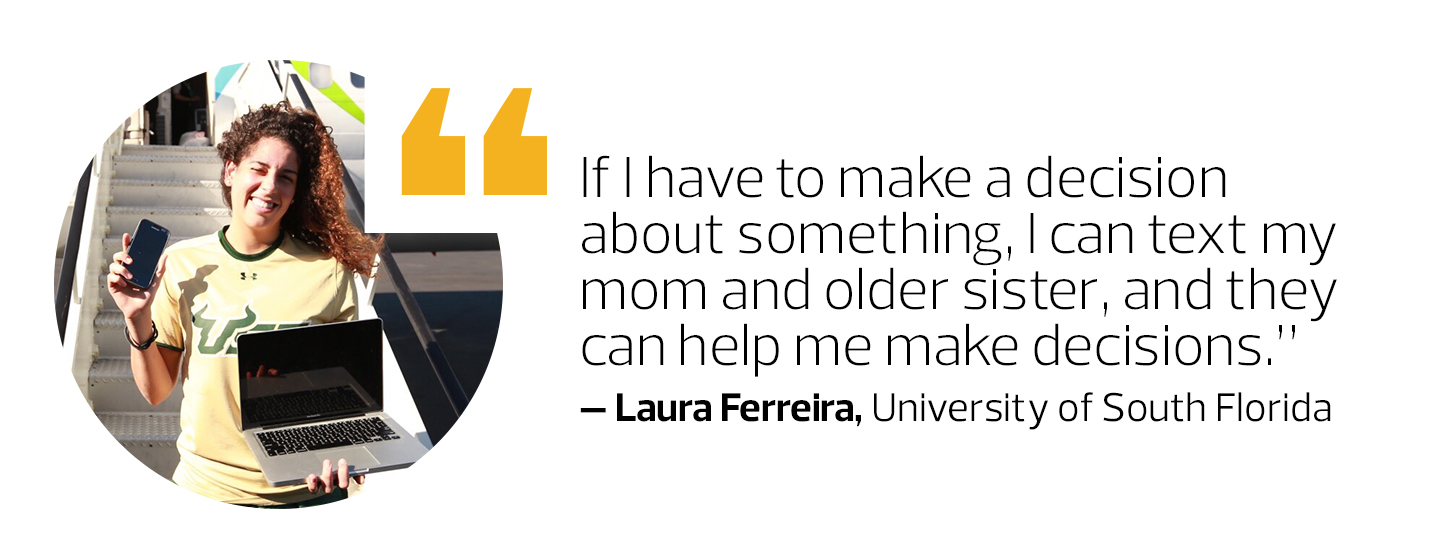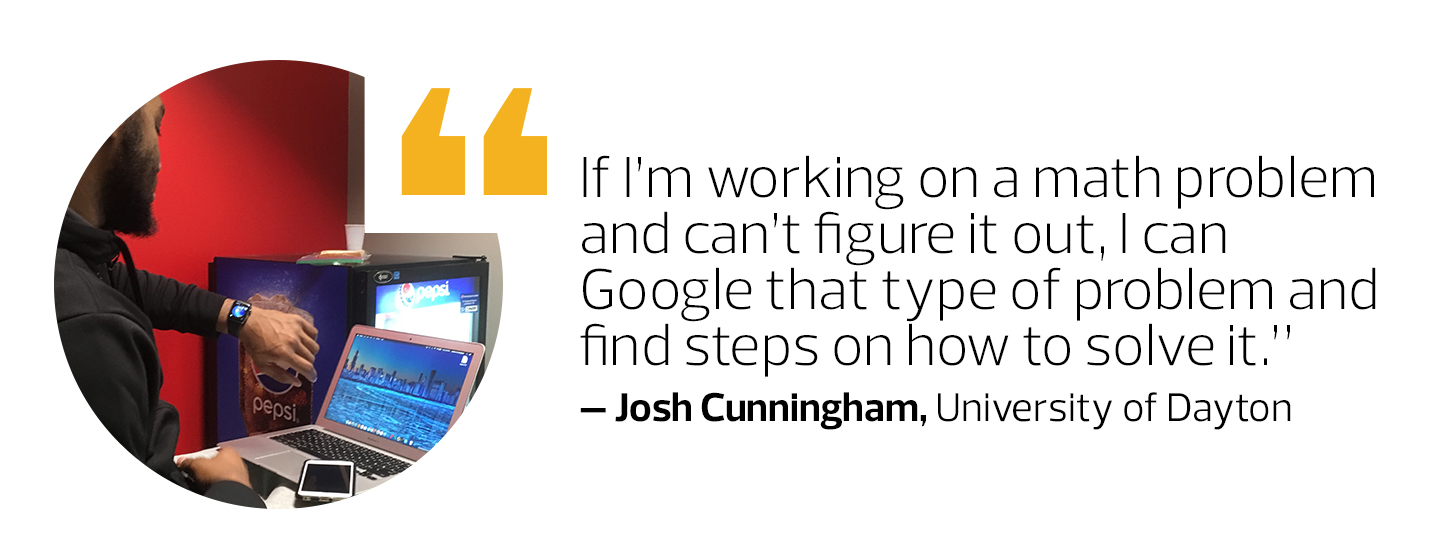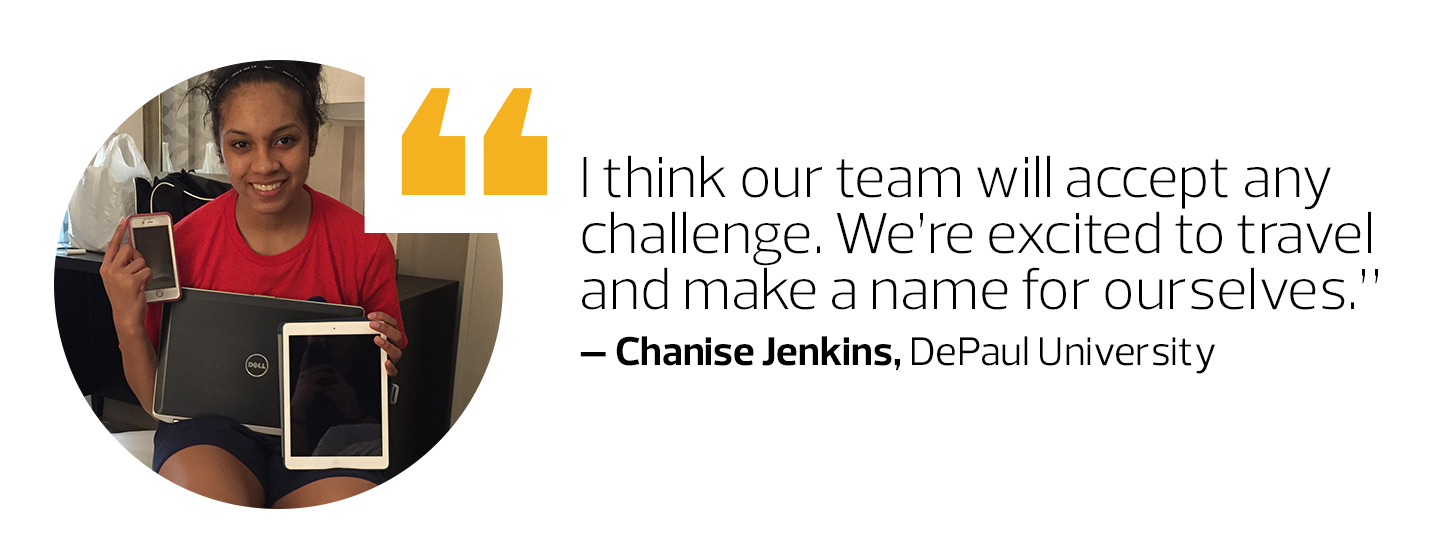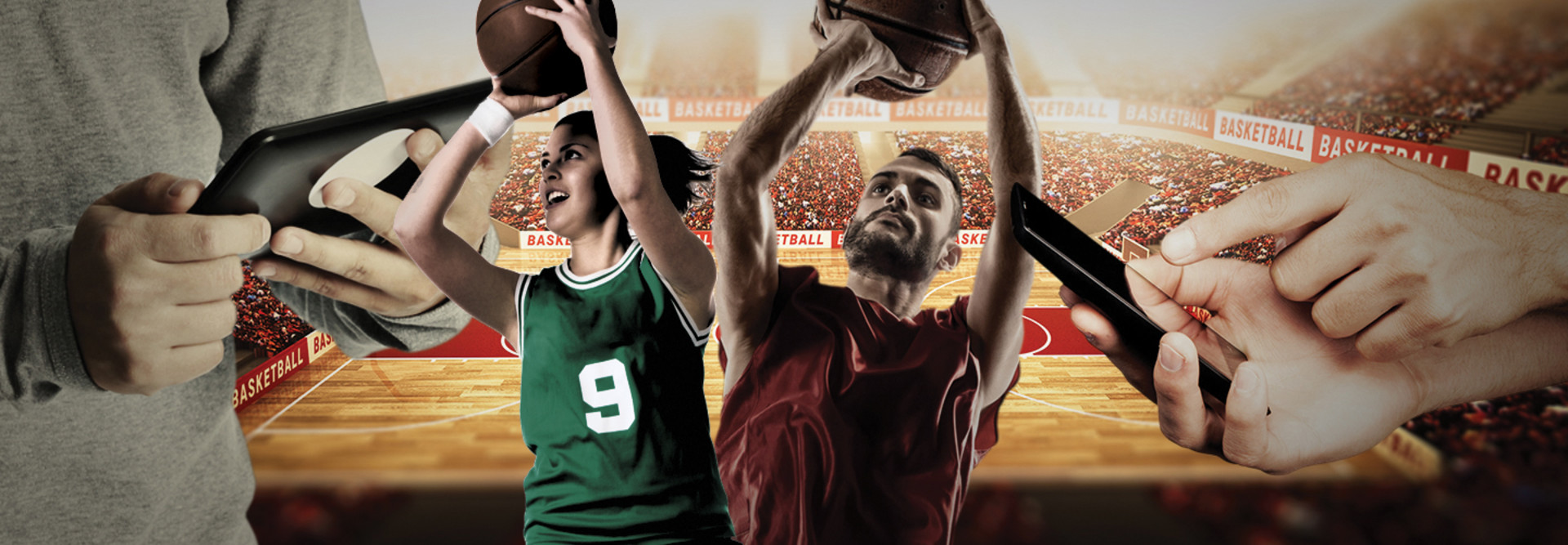How College Basketball Players Make Technology Part of Their Everyday Lives
Chanise Jenkins can’t help it. Like many college students, the DePaul University senior sometimes needs to check her iPhone every few minutes.
There might be a missed call, a new text message or an interesting new tweet. Or, when she’s hungry, she can check for updates from GrubHub, a food ordering and delivery app. She gets real-time alerts to her phone when her restaurant order is being prepared and on its way for delivery.
“I love the app. I love food, so I spend a lot of time ordering food,” Jenkins says, laughing.
At the University of Dayton, Josh Cunningham has a cool new addition to his wardrobe: an Apple Watch, which his mom gave him for Christmas. As he rushes from class to class, he now receives all his iPhone notifications on his wrist, which include helpful reminders that he has a scheduled workout with a trainer.
And at the University of South Florida, while traveling for basketball games during the season, Laura Ferreira uses her Samsung Galaxy S5 phone to log in to the school’s learning management system so she can view assignments and message her professors with questions.
The three college students don’t know each other, but they share a bond in their reliance on technology and passion for college hoops. In fact, they’re all headed to the Big Dance — the NCAA Men’s and Women’s Division I Basketball Championship Tournaments.
On Friday, Jenkins suited up as the starting point guard for DePaul’s women’s basketball team as her No. 6 seed team took on No. 11 James Madison in the first round of the NCAA Tournament in Louisville, Ky. and won.
Cunningham, who transferred from Bradley University to the University of Dayton in Ohio this year, is required by NCAA rules to sit out the season, so he can’t travel with the team. Nonetheless, he made the trip to St. Louis on his own to root his teammates as they faced Syracuse University in the tournament’s first round, where they were defeated 70 to 51.
And Ferreira, a small forward who averaged 10.3 points and 4.7 rebounds per game in her sophomore season, traveled to Los Angeles, where her team played Colorado State on Saturday and emerged victorious.
“I’m excited,” says Ferreira, an international student from Portugal, ahead of the game. “Our team is better than last year’s team. We’re going to have fun. I can’t wait.”
Technology plays a meaningful and impactful role in the lives of these college basketball players, who as student-athletes must balance academics, athletics and their personal lives. Mobile devices in particular play a crucial role in helping the students stay connected and empowering them to manage and meet all the demands on their time, energy and attention.
Technology Supports Players’ Constant Communication Needs
In 2014, Ferreira left Portugal and moved to Tampa, Fla., to attend USF and pursue a degree in exercise science. It was a big transition for the then-19-year-old, who had played for Portugal’s national team and was named the country’s best player two years in a row.
“Everything is different: the language, culture, food, the people,” she recalls.
Fortunately, the team has a handful of other international players who understood what she was going through and provided support. And thanks to technology, her family was always just a Skype call or text message away.
Now in her second year, Ferreira has overcome her culture shock and is feeling more settled. On weekends, she flips open her MacBook to do Skype calls with her family, and throughout the week, she text messages them using WhatsApp and Facebook Messenger on her smartphone.

“I get support from my family,” says Ferreira, who plans to one day use her degree to become a strength coach. “If I have to make a decision about something, I can text my mom and older sister, and they can help me make decisions.”
Communication is a significant motivation for Ferreira’s embrace of technology. She relies on technology to communicate with not only her family in Europe, but also her teammates and professors.
Her basketball team uses Microsoft’s GroupMe text messaging app, which coaches use to inform players of practice changes and travel logistics for away games.
When Ferreira is traveling for games, she uses the learning management system phone app to message her professors to tell them she will miss class. Sometimes she asks questions about assignments, and sometimes she schedules meetings during office hours so she can catch up on what she missed.
“I reach out to my teachers pretty often, and they reply really fast,” she says.
Technology Supports Academic and Athletic Studies
As a 19-year-old, Cunningham was too young to watch Michael Jordan in his prime as he won his final championships with the Chicago Bulls in the late 1990s. But while he was growing up in Chicago, his mom would fondly reminisce about the legendary player.
“My mother is into sports, and she would tell me how good he was and how she enjoyed watching him play and how he tried to separate himself and let people know that he could dominate,” he says.
Cunningham dominated in high school. As a high school senior in 2013-2014, he averaged 21.6 points and 14.5 rebounds and was named one of the country’s top 100 players. After red-shirting this season, Cunningham has three years of eligibility left as a player, and he expects to be a big part of the team next season.
“It’s a great basketball program, and the education here is excellent,” he says. “I felt I had a connection with the coaching staff and the team as soon as I stepped foot on campus.”
The University of Dayton also invests in technology to give the basketball team a competitive edge. Dayton head coach Archie Miller reviews game and practice video footage with the players at the university’s Cronin Athletics Center, where they meet in a classroom with a large HDTV. Miller shows the video clips that have the most teaching potential, as well as examples of a job well done, says Brian Frank, a graduate assistant who works with the team.
The team also equips each player with iPads. The team’s video coordinator uploads video clips and scouting reports to a server, and the content is delivered to each player’s iPad, regardless of their location. That way, players can prepare for games during their free time.
“What we upload on the players’ iPads varies from the other team’s offense or defense, personnel or things our players might need to work on,” Frank says.

Cunningham has been rehabbing from shoulder surgery, so he hasn’t been able to practice much with the team this year. But just being around the team and attending practice and meetings allows him to prepare for next season and is helping him improve as a player, he says.
“Being able to sit back and watch helps,” he says. “I get to study the game more and see things that you don’t see while you are playing. You see the things coaches are talking about, and I feel that could help me better my skills and basketball IQ.”
In the meantime, he’s able to focus on his studies. He’s a sophomore, majoring in communications and considering a degree in business, and like his peers, Cunningham finds that technology plays a critical role in his everyday life.
He’s really close to his mom, and he talks to her daily on his phone. He subscribes to Apple Music to listen to his favorite musicians, Kanye West, Jay Z, Drake and Meek Mill, and he uses his MacBook Air to do homework. Some teachers require that students bring their computers to class so they can work on projects while they are there. And like so many of us today, he relies on online research to educate himself on subjects he’s unfamiliar with.
“If I’m working on a math problem and can’t figure it out, I can Google that type of problem and find steps on how to solve it,” he says.
Technology Supports a Positive Social Message
Chanise Jenkins understands the power and responsibility that come with being a person of influence.
The Big East Conference Player of the Year is a social media power user, having tweeted 21,200 times since she joined the social network 5½ years ago. She also has nearly 2,000 followers on Instagram.
While she uses Twitter to promote games and her team, she recognizes that many of her Twitter followers are young fans, so she tweets and retweets inspirational and motivational quotes.
For example, on March 14, Jenkins tweeted:
If you truly believe you are one of the best, you have a better chance of succeeding than thinking "I hope I'm good"
— Chanise Jenkins (@trixyJ13) March 14, 2016
She followed that tweet with another:
"If your effort is low, you're probably not thinking about the opportunity, you're probably thinking about the obligation"#TrixyJ™
— Chanise Jenkins (@trixyJ13) March 14, 2016
Jenkins, who won a gold medal on the USA women’s basketball team at the 2015 World University Games, says she wants to be a good influence. Her younger sister is in high school, and many of her sister’s friends follow her. Children who attend DePaul’s basketball games also follow her.
“I try my best to be socially responsible,” she says. “Social media allows me to send out positive messages to people. I think sometimes people need to hear from others that they understand what they are going through.”

Her gold iPhone 6 is her go-to device, but she also uses a tablet to watch Netflix. (She just finished “Gossip Girl” and is now catching up on “Grey’s Anatomy.”) Jenkins also uses a Windows notebook computer for her school work and to prepare for basketball games. Her coaches give each player DVDs with video and scouting reports, and she uses them to study upcoming opponents before each game.
The team’s video coordinator collects video of competitors’ games, and the coaching staff breaks down the video and develops game plans. The video allow Jenkins and her teammates to analyze their opponents, while the scouting reports provide details, such as opposing players' tendencies and the types of offensive plays they run or how they like to set up their defense.
Jenkins will earn her master’s in sports fitness and recreation leadership this spring. Once she graduates, she hopes to play in the WNBA or professionally overseas. In the meantime, her main goal is to lead her team deep into the NCAA tournament.
“I’m very excited,” says Jenkins, who leads her team with 14.9 points per game. “I think our team will accept any challenge. We’re excited to travel and make a name for ourselves.”
To learn more about how technology is changing college basketball, check out the other stories in our March Madness 2016 content series.









